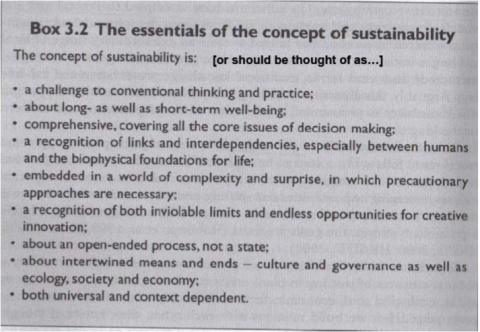Sustainable development famously defined in terms of:
development that meets the needs of the present without compromising the ability of future generations to meet their own needs (WCED 1987). Originally a reaction to the failure of conventional development in terms of its failure to alleviate poverty instead creating greater economic disparity and its destruction of life-supporting ecological resources.
"Sustainable community development is the ability to make development choices which respect the relationship between the three "E's"-economy, ecology, and equity:
- Economy - Economic activity should serve the common good, be self-renewing, and build local assets and self-reliance.
- Ecology - Humans are part of nature, nature has limits, and communities are responsible for protecting and building natural assets.
- Equity - The opportunity for full participation in all activities, benefits, and decision-making of a society." (MACED.org)
 Key themes with respect to sustainable community development in Northern Europe we will likely be exploring:
Key themes with respect to sustainable community development in Northern Europe we will likely be exploring:
- sustainability, regeneration, resilience
- community % society (Gemeinschaft & Gesselschaft)
- (social / environmental) justice & equity
- place / social /regional / national imaginaries, discourses, & identities
- neoliberalism % (social) democracy
- planning & policy
- integration % dis-integration (commonality % diversity)
- commons % private property
- globalization % (re)localization
- urban political ecology
- contested space
- waterfront redevelopment / eco-districts
- urban agriculture
- active transportation
- housing
- ecological education, community engaged research and learning, university/ community partnerships
- green mapping
Sustainability as a contested social construction:
Over the last [couple decades], the concept of sustainability has been widely, if vaguely, embraced by government bodies and other influential organizations around the world. Its meaning and implications have been much disputed, and the actual behaviour of institutions that have claimed devotion to sustainability has been criticized. The idea, however, has persisted and spread. – Gibson (2005: 38)
We live in an age of sustainababble a cacophonous profusion of uses of the word sustainable to mean anything from environmentally better to cool… To find sustainable in such common use indicates that a key environmental concept now enjoys general currency in popular culture. But sustainababble has a high cost…“Sustainable” has morphed from its original meaning into something like “a little better for the environment than the alternative”. Simply doing “better” environmentally will not stop the unraveling of ecological relationships we depend on for food and health. – Engelmann (2013)
Sustainability is slippery in that “it is notoriously difficult to define; embraced with equal fervour by those who would never agree on even the first step towards its attainment; and even among those groups and individuals actively pursuing it, it seems the more they do, the farther they get from the goal.” It is sticky in that “despite a quarter century of prognostications of its terminally diseased condition, as a passing ideal and an overly intellectualized pairing of poverty alleviation and environmental goals, sustainability has persisted and carries cash value as an organizing frame for policy and planning.” – Holden (2015)

Questions guiding inquiry:
For each speaker we meet explore the following:
- What is their diagnosis of the present? How do they define the current problem? issues? concerns? to them what makes the system dysfunctional?
- What do they see as the horizon of possibility? desired future? the world they want to call into being?
- What specific pathways do they see that would lead to that future? practices? policies? technologies? personal and collective actions? new understandings? new stories? new connections?
- What barriers do they imagine standing in the way? personal, cultural, systematic-structural factors inhibit the possibility of another world?
Be ever mindful (as much as possible) of your own lens. Be reflexive, open-minded, vigilant.
On critical questioning
Children come into the world of wonder consumed with a desire for knowledge – demanding to know the who, what, when, where and why of life…sadly, their passion for thinking often ends when they encounter a world that seeks to educate them for conformity and obedience only…critical thinking involves first discovering … those eternal questions of the inquisitive child and then using that knowledge in a manner that enables you to determine what matters most. – bell hooks
Grasp onto some specific questions that you are genuinely curious about…

